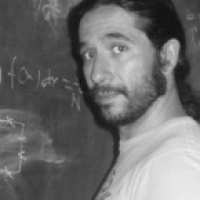The Severo Ochoa Training Programme comprises high-profile lecture series and PhD courses presented by global experts, which are linked to the Excellence Visitors Programme and are organised jointly with the Department of Theoretical Physics at UAM.
PhD courses

Cosmological phase transitions and production rates
Mikko Laine, BERNJanuary 2024
Abstract
In this set of five lectures, standard tools and notions met in the study of particle cosmology are discussed. We start with how to reliably address phase transitions driven by a weakly coupled scalar field, and move on to outline the production of gravitational waves, baryon asymmetry, or magnetic fields, from such phase transitions, or from particle scatterings in the early universe.

An introduction to anomalies in particle physics
David Kaplan, U. WashingtonJuly 2023
Contents
- Derivation of chiral anomalies in two and four dimensions
- The relation between anomalies and index theorems
- Instantons and the theta vacuum
- The strong OP problem and axions
- ’t Hooft anomaly matching criterion
- Chiral gauge theories
- Anomalies on the lattice: Ginsparg-Wilson fermions
- Parity anomaly
- Global anomalies
- Domain wall fermions, the integer quantum hall effect, and topology in momentum space.

Julia for Scientists
alberto ramos, IFICMarch 2023
Abstract
This course targets PhD students that perform numerical simulations/computations in their research. We will address different computational problems in the areas of dynamical systems, algorithms and linear algebra and solve them using the Julia language. The course does not requires any previous knowledge of the language, since the main characteristics and advantages of the Julia language will be explained during the course. However having experience with *another* programming language (python, FORTRAN, C, …) will be useful. The main objectives of the course is to learn how to write efficient and reproducible data analysis tools useful for the scientific community.

Effective Chiral Lagrangian
Stefano Rigolin, U. PadovaJanuary – February 2023
Contents
- The linear sigma model and its symmetries. To introduce the notation we will discuss the simplest examples of linear sigma model, namely the ones for a U(1)-singlet and SU(2)-doublet (i.e. SO(4)) complex scalar field. Application: the SM custodial symmetry. Representation invariance of the linear sigma model.
- Spontaneous symmetry breaking of the linear sigma model. pi+pi scattering and check of representation invariance. Coupling the sigma model with fermion and fermion masses. Application: QCD at low energy (optional)
- The non-linear sigma model as an effective field theory. The SO(4)/S0(3) effective Lagrangian. Integrating out the “radial” degree of freedom (equation of motion approach). Higher order operators as expansion in momenta.
- The chiral effective Lagrangian. Leading and Next to Leading Order operators. Application to the SU(2)_L x SU(2)_R/ SU(2)_V symmetry breaking case. Introducing Gauge interactions to the chiral effective Lagrangian. Explicit Symmetry breaking terms.
- Optional: CCWZ formalism and/or Axion Chiral Lagrangian

Effective field Theory in Particle Physics
Ben Grinstein, U. de California San DiegoNovember 2022
Abstract & Contents
The course is an introduction to Effective Field Theory in particle physics, with an emphasis on the applications to weak interactions and grand unification, but includes also brief discussion of wilsonian effective action, SMEFT and Heavy Quark Effective Theory (HQET).
- Why do we need EFT? Challenges of EFT.
- Appelquist Carazzone Theorem.
- Grand Unified Theories.
- Renormalisation Group. Renormalisation of composite operators.
- Operator anomalous dimensions: explicit computations.
- Operator mixing and their RGE.
- Using symmetries and equations of motion (EOM) to constrain mixing of operators.
- Prove Equations of Motion in elements.
- Wilsonian EFT and relation to renormalziation in QFT (minimalistic).
- Heavy Quark Effective Theory.

Introduction to FORM
Jos Vermasseren, NIKHEFNovember 2022
Abstract
Form is a program for the fast symbolic manipulation of very big formula’s. It is being used for many of the big perturbative calculations in field theory, but also in some mathematical calculations it has been able to obtain results that could not be obtained by other means. The first three sessions make the attendants familiar with the underlying philosophy and basic commands and explain a few fundamentals about how to make fast programs. This will be followed by three actual research problems in the fields of gravity, Euler characteristics and integration by part reductions respectively.

Consistent EFTs
Ferruccio Feruglio, U. Padova and INFNMarch – April 2022
Abstract & Contents
Even without reference to UV completions that include gravity (like e.g. string theory), generic effective field theories might be inconsistent and be part of a “swampland”. These lectures aim at introducing the basic constraints that a consistent EFT should satisfy. Positivity bounds on Wilson coefficients and restrictions from gauge anomaly cancellation will be illustrated at an introductory level. Several simple examples will be worked out, both in a top-down and in a bottom up-approach.
- Positivity bounds in scalar EFT
- Positivity bounds in the Euler-Heisenberg EFT
- Gauge anomaly cancellation in EFT: non-anomalous field content
- Gauge anomaly cancellation in EFT: anomalous field content
- Some applications: birefringence of the vacuum in axion low-energy theories,
- Pion decay into two photons, a-theorem and irreversibility of RGE flow,…

Flavour Physics
Yossi Nir, Weizmann Institute of ScienceMarch 2022
Abstract
Flavour physics provides stringent tests of the Standard Model (SM) and probes new physics (NP). I will present the predictions of the SM: The universality of the strong, electromagnetic and neutral-current weak interactions, the diagonality of the Yukawa interactions, and the special features of the charged-current weak interactions. I will explain why flavour changing neutral current processes are highly suppressed in the SM, and how they are used to test the SM and to probe NP. I will introduce the SM flavour puzzle and the NP flavour puzzle, and describe various proposed solutions. The surprising features of the neutrino flavour structure will be presented. Finally, current flavour anomalies will be described.